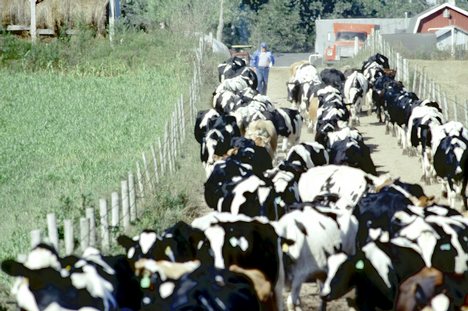February 14, 2011

Ed DePeters, Animal Scientist, UC Davis; Jennifer Heguy, Dairy Advisor, UCCE Stanislaus & San Joaquin Counties: Field Notes
Milk quality starts on the farm. The processing plant cannot improve the quality of your milk; it can only maintain the quality that you deliver. In a recent article we talked about preparing cows in the milk parlor. (Read it online). In this article, we‘ll continue the discussion of producing quality milk by explaining your milk laboratory results and highlighting reasonable goals for your dairy.
Quality standards for market milk (Grade A):
Standard plate count (maximum): 50,000 bacteria per milliliter of milk
Laboratory pasteurization count (maximum): 750 bacteria per milliliter of milk
Coliform (maximum): 750 bacteria per milliliter of milk
Somatic cell count (maximum): 600,000 cells per milliliter of milk
What do these standards refer to?
Standard Plate Count (SPC) is a measure of the bacteria present in bulk tank milk. Basically, a sample of milk is plated and the number of colonies counted. It is an estimate of the total aerobic bacteria (those which can live in the presence of oxygen). High SPC may indicate inadequate refrigeration, but it is not an indication of udder health (mastitis). A goal may be to have a SPC of 5,000 or lower.
Laboratory Pasteurization Count (LPC) is the cell count of bacteria after a raw milk sample has been lab pasteurized. It is similar to the SPC except the milk is pasteurized. The organisms that survive pasteurization and grow on the plate most often originate from the soil environment. High LPC indicates improper cleaning procedures. Check the cleaning procedures so that there are no residues in the pipeline, traps, and tank. Check the temperature of the wash water during the wash cycle. Check the quality of the soap and cleaning chemicals. Check the cow preparation in the milking parlor so there is no feed, dirt, feces, or other foreign organic material on the teats and udder that will contaminate the milk. An-other potential cause of high LPC is long milking shifts. In-line filters should be changed out as appropriate if milking lasts longer than four hours. A high LPC is not an indication of general udder health (mastitis). A goal may be a LPC of 100 or less.
Coliform count
Coliform Count is a measure of the level of sanitation of the cow (teats and udder) and the milking equipment. These bacteria are associated with the fecal environment. In the parlor, ensure that only clean, dry teats are milked. Check to be sure that the wash system is cleaning and disinfecting the surfaces of the milking equipment where milk comes into contact - from the inflations to the pipeline to the bulk tank. A high coliform count does not reflect udder health (mastitis). A goal may be a coliform count of 50 or less.
Somatic Cell Count (SCC) is a measure of udder health. SCC is a measure of all cells in milk. Cells are primarily leukocytes (white blood cells) along with epithelial cells that are sloughed from within the mammary gland. Leukocytes are products of the cow‘s immune system that move into the mammary gland in response to an inflammation (mastitis). The SCC is a measure of udder health and mastitis. High SCC in the bulk tank is an indication of a problem in the herd. To detect problem cows, milk must be sampled from individual cows for SCC. Bulk tank milk with high SCC has poor processing qualities and a reduced shelf life at the retail level. A goal may be a SCC of 100,000 or less.
How is the finished dairy product affected by milk quality?
Bulk tank milk is pasteurized at the processing plant or creamery. Pasteurization is the process of heating milk for a predetermined time at a predetermined temperature to destroy pathogens. Pasteurization is based on destroying Coxiella burnetii (agent causing Q fever), the most heat-resistant organisms of public health concern. Bacteria are killed at a rate that is proportional to the number of bacteria present in milk, meaning milk that is pasteurized is not sterile. The number of bacteria pre-sent in pasteurized milk depends on the number of bacteria delivered from the farm to the processing plant. The lower the number of bacteria in the milk from a dairy, the lower the number of organisms present in milk following pasteurization. High quality milk from dairies is necessary to produce the high quality dairy products that consumers demand. Quality milk is also associated with longer shelf life at the retail level.
Laboratory milk test results provide necessary information to make management decisions on the farm in order to produce high quality milk. Consumers trust that California produces high quality dairy products, and that quality starts on the farm!
You May Also Like




